
Logging is the process of cutting, processing, and moving trees to a location for transport. It may include skidding, on-site processing, and loading of trees or logs onto trucks or skeleton cars. In forestry, the term logging is sometimes used narrowly to describe the logistics of moving wood from the stump to somewhere outside the forest, usually a sawmill or a lumber yard. In common usage, however, the term may cover a range of forestry or silviculture activities.

Lumberjack is a mostly North American term for workers in the logging industry who perform the initial harvesting and transport of trees. The term usually refers to loggers in the era before 1945 in the United States, when trees were felled using hand tools and dragged by oxen to rivers.

A chainsaw is a portable handheld power saw that cuts with a set of teeth attached to a rotating chain driven along a guide bar.
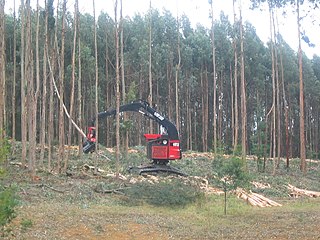
Pulpwood can be defined as timber that is ground and processed into a fibrous pulp. It is a versatile natural resource commonly used for paper-making but also made into low-grade wood and used for chips, energy, pellets, and engineered products.

A skidder is any type of heavy vehicle used in a logging operation for pulling cut trees out of a forest in a process called "skidding", in which the logs are transported from the cutting site to a landing. There they are loaded onto trucks, and sent to the mill. One exception is that in the early days of logging, when distances from the timberline to the mill were shorter, the landing stage was omitted altogether, and the "skidder" would have been used as the main road vehicle, in place of the trucks, railroad, or flume. Modern forms of skidders can pull trees with a cable and winch, just like the old steam donkeys, or with a hydraulic grapple either on boom or on the back of the frame (clambunk skidder).

A forwarder is a forestry vehicle that carries big felled logs cut by a harvester from the stump to a roadside landing for later acquisition. Forwarders can use rubber tires or tracks. Unlike a skidder, a forwarder carries logs clear of the ground, which can reduce soil impacts but tends to limit the size of the logs it can move. Forwarders are typically employed together with harvesters in cut-to-length logging operations. Forwarders originated in Scandinavia.
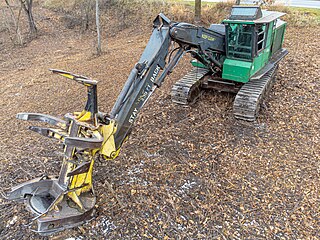
A feller buncher is a type of harvester used in logging. It is a motorized vehicle with an attachment that can rapidly gather and cut a tree before felling it.
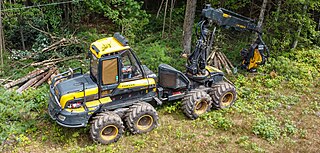
A harvester is a type of heavy forestry vehicle employed in cut-to-length logging operations for felling, delimbing and bucking trees. A forest harvester is typically employed together with a skidder that hauls the logs to a roadside landing, for a forwarder to pick up and haul away.
Silviculture is the practice of controlling the growth, composition/structure, as well as quality of forests to meet values and needs, specifically timber production.
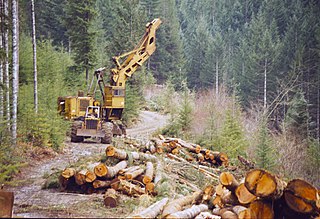
A swing yarder is a mobile piece of heavy duty forestry equipment used for pulling logs from the woods to a logging road with cables. The swing yarder is also known as a grapple yarder.

Bucking is the process of cutting a felled and delimbed tree into logs. Significant value can be lost by sub-optimal bucking because logs destined for plywood, lumber, and pulp each have their own value and specifications for length, diameter, and defects. Cutting from the top down is overbucking and from the bottom up is underbucking.
Sakari Pinomäki (1933–2011) was a Finnish systems engineer and an inventor, who pioneered the mechanized forestry industry. He was the founder of PIKA Forest Machines which produced the first purpose-built forest machine in 1964 in Ylöjärvi , Finland. His inventions had over 50 patents.
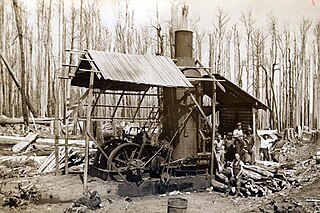
The Washington Winch sits in the forests of eastern Victoria near Swifts Creek and is also known as the Washington Iron Works Skidder.
The following outline is provided as an overview of and guide to forestry:

Felling is the process of cutting down trees, an element of the task of logging. The person cutting the trees is a lumberjack. A feller buncher is a machine capable of felling a single large tree or grouping and felling several small ones simultaneously.
Underwater logging is the process of logging trees from underwater forests. When artificial reservoirs and dams are built, large areas of forest are often inundated; although the trees die, the wood is often preserved. The trees can then be felled using special underwater machinery and floated up to the surface. One such machine is the sawfish harvester. There is an ongoing debate to determine whether or not underwater logging is a sustainable practice and if it is more environmentally sustainable than traditional logging.

Heli-logging, or helicopter logging, is a method of logging that uses helicopters to remove cut trees from forests by lifting them on cables attached to a helicopter. Helicopter logging is often used in inaccessible areas of forests. Because the use of helicopters reduces the level of infrastructure required to log in a specific location, the method also helps to reduce the environmental impact of logging. It also can increase the productivity in these remote areas.
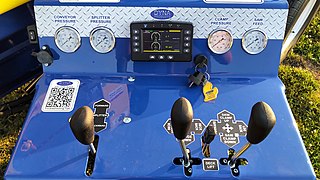
A firewood processor is a machine designed to cut and split firewood with minimal manual handling of the logs. There are typically four main parts of the machine, each dedicated to a separate function. Processing begins with a log pile – a pile of logs that have been de-limbed and cut to an appropriate length, generally 12–20 feet (3.7–6.1 m). Popular brands include DYNA, Multitek, Eastonmade, Cord King, Wood Beaver, Hakki Pilke, and Blockbuster. Many individuals use processors commercially, while some use them privately as a hobby. If someone has a small amount of wood they'd like to split but don't want to spend a lot of money, there's options to rent processors as an alternative to purchasing.
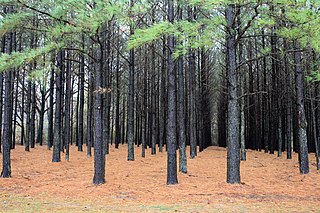
A tree plantation, forest plantation, plantation forest, timber plantation or tree farm is a forest planted for high volume production of wood, usually by planting one type of tree as a monoculture forest. The term tree farm also is used to refer to tree nurseries and Christmas tree farms. Plantation forestry can produce a high volume of wood in a short period of time. Plantations are grown by state forestry authorities and/or the paper and wood industries and other private landowners. Christmas trees are often grown on plantations, and in southern and southeastern Asia, teak plantations have recently replaced the natural forest.

Skidding in forestry is the first operation after logging: it consists of transporting felled trees from the felling site to a temporary dumping site, known technically as a "loader", near a road or track suitable for further transport. This name is still applied to the first emptying of stones in quarries or stone heaps and possibly heavy equipment in mines, to heavy transport operations and cumbersome handling.

















